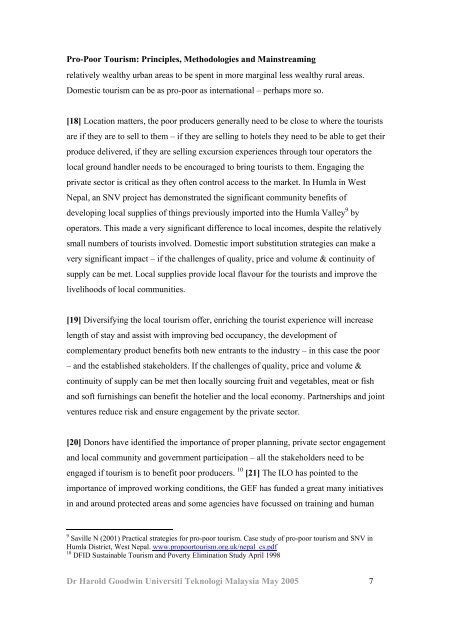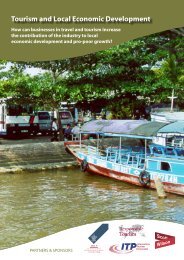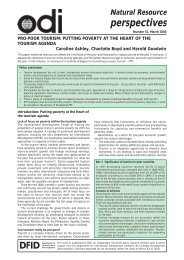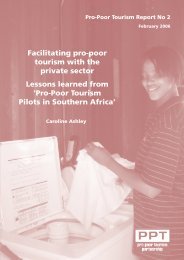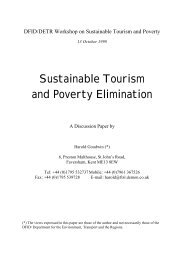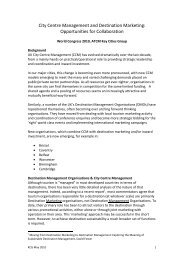Pro-Poor Tourism: Principles, Methodologies and ... - Harold Goodwin
Pro-Poor Tourism: Principles, Methodologies and ... - Harold Goodwin
Pro-Poor Tourism: Principles, Methodologies and ... - Harold Goodwin
You also want an ePaper? Increase the reach of your titles
YUMPU automatically turns print PDFs into web optimized ePapers that Google loves.
<strong>Pro</strong>-<strong>Poor</strong> <strong>Tourism</strong>: <strong>Principles</strong>, <strong>Methodologies</strong> <strong>and</strong> Mainstreamingrelatively wealthy urban areas to be spent in more marginal less wealthy rural areas.Domestic tourism can be as pro-poor as international – perhaps more so.[18] Location matters, the poor producers generally need to be close to where the touristsare if they are to sell to them – if they are selling to hotels they need to be able to get theirproduce delivered, if they are selling excursion experiences through tour operators thelocal ground h<strong>and</strong>ler needs to be encouraged to bring tourists to them. Engaging theprivate sector is critical as they often control access to the market. In Humla in WestNepal, an SNV project has demonstrated the significant community benefits ofdeveloping local supplies of things previously imported into the Humla Valley 9 byoperators. This made a very significant difference to local incomes, despite the relativelysmall numbers of tourists involved. Domestic import substitution strategies can make avery significant impact – if the challenges of quality, price <strong>and</strong> volume & continuity ofsupply can be met. Local supplies provide local flavour for the tourists <strong>and</strong> improve thelivelihoods of local communities.[19] Diversifying the local tourism offer, enriching the tourist experience will increaselength of stay <strong>and</strong> assist with improving bed occupancy, the development ofcomplementary product benefits both new entrants to the industry – in this case the poor– <strong>and</strong> the established stakeholders. If the challenges of quality, price <strong>and</strong> volume &continuity of supply can be met then locally sourcing fruit <strong>and</strong> vegetables, meat or fish<strong>and</strong> soft furnishings can benefit the hotelier <strong>and</strong> the local economy. Partnerships <strong>and</strong> jointventures reduce risk <strong>and</strong> ensure engagement by the private sector.[20] Donors have identified the importance of proper planning, private sector engagement<strong>and</strong> local community <strong>and</strong> government participation – all the stakeholders need to beengaged if tourism is to benefit poor producers. 10 [21] The ILO has pointed to theimportance of improved working conditions, the GEF has funded a great many initiativesin <strong>and</strong> around protected areas <strong>and</strong> some agencies have focussed on training <strong>and</strong> human9 Saville N (2001) Practical strategies for pro-poor tourism. Case study of pro-poor tourism <strong>and</strong> SNV inHumla District, West Nepal. www.propoortourism.org.uk/nepal_cs.pdf10 DFID Sustainable <strong>Tourism</strong> <strong>and</strong> Poverty Elimination Study April 1998Dr <strong>Harold</strong> <strong>Goodwin</strong> Universiti Teknologi Malaysia May 2005 7


